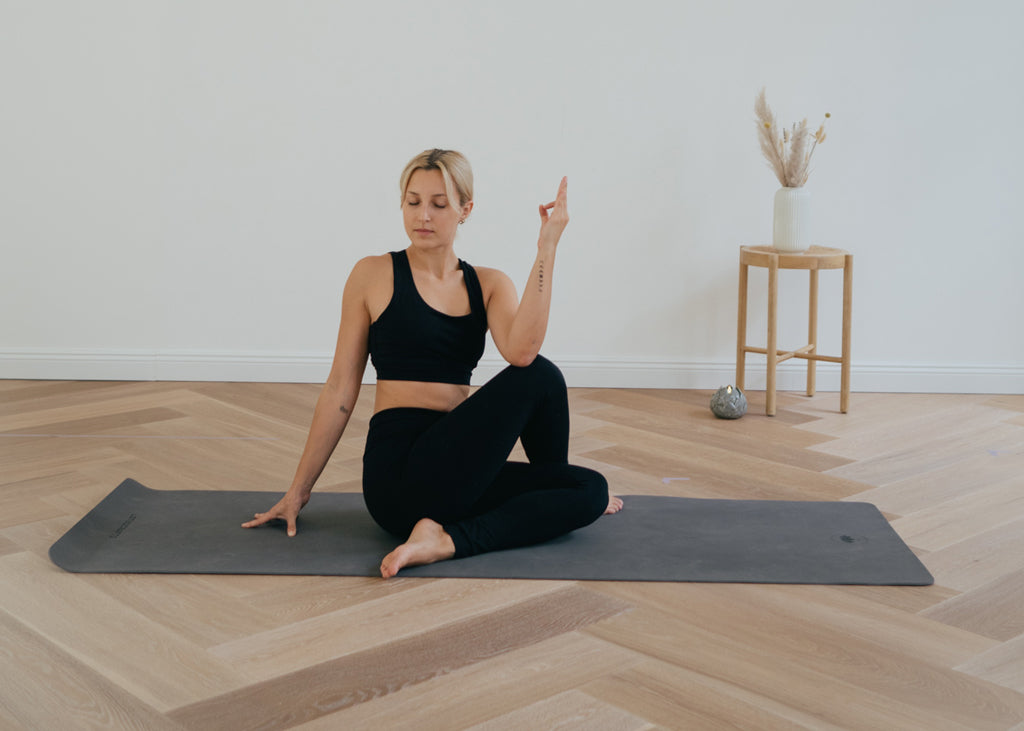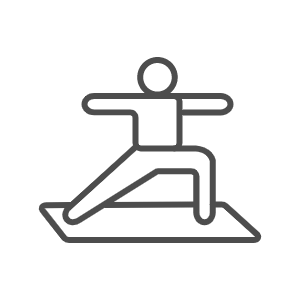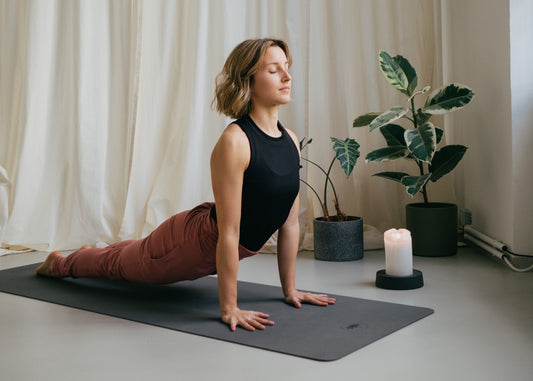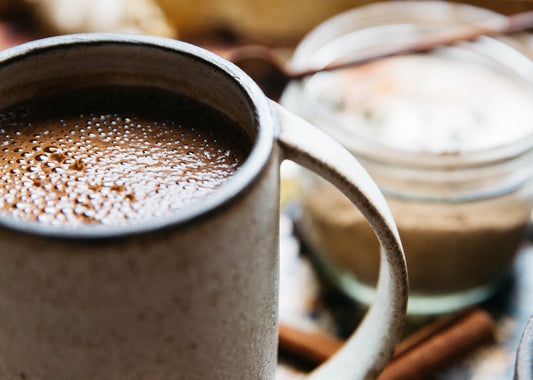Everyone who is interested in yoga has probably come across the topic or the term “chakra”. However, many of us - especially in the western world - do not know what exactly is meant by this and what comprehensive teaching is behind it.

In the following blog article we would like to accompany you into the world of chakras and decode them for you. Most people who practice yoga actually already have a clear idea of the chakras, because there are the 7 main chakras that are mentioned in one or the other yoga unit.
What are chakras/chakras?
The Sanskrit word "chakra" means "wheel " or "disc" . In yoga, meditation and Ayurveda, this term describes the energy wheels in the body. There are seven main chakras that align along the spine, going from the base of the spine to the top of the head. The spheres run along the spine but also extend across the front, back and both sides of the body. Chakras are spinning vortices of energy that are imperceptible to the human eye but can be seen, felt and sensed with intuition. Known as prana, this invisible healing energy is a vital life force that keeps us vibrant, healthy and vibrant.
The chakras are the centers of life energy or consciousness, which lie in the subtle body shell. The 7 main chakras lie along the subtle spine (sushumna) and are surrounded by the two main nadis, Ida Nadi and Pingala Nadi. They form, so to speak, centers of consciousness and storage places for the energy forces.
However, before we delve further into the chakras, let's take a quick look at the nadis .
Nadis are energy channels in our body through which prana , i.e. life energy, flows to every cell in the body. Humans have a large number of nadis, which is currently estimated to be between 72,000 and 350,000, and where these channels cross, energetic nodes arise: chakras
Chakras are understood as subtle energy points inside and outside of the body. They have the task of absorbing the energy from outside and then making it accessible to the human energy system.
The knowledge of the chakra theory has its origins in the millennia-old Vedic scriptures and Upanishads, the ancient philosophical scriptures of Hinduism, but also in other spiritual concepts such as TCM or among the Tibetans.
Both the Upanishads and the Vedas are part of the Vedic religion, which is the oldest verifiable religion in India. However, as is so often the case with such old traditions, it is not possible to clearly determine the exact origin of the deep knowledge of the chakra teachings, since much of it was passed on orally.
Here we have already put together a chakra guide for you that explains each chakra and its task.
Chakra Yoga Practice: Get the energy flowing in your chakras
There are now some tools to bring your chakras into harmony and to maintain this state, so you could try chakra meditation or practice chakra yoga, in which you perform asanas that address a specific chakra. We show you some exercises in this blog post.
When we fundamentally take care of our physical, emotional, mental, and spiritual health, we can increase the flow of energy through our chakras with ease. For example, yoga is one way we can encourage and improve the flow of our chakra systems. Decluttering our lives, both physically and emotionally, helps us balance this flow of energy. Forgiveness, surrender and equanimity greatly strengthen our energetic health. Of course, meditation, pranayama and a mindful lifestyle help to experience well-being on all levels.
Exercises for the 7 main chakras
Muladhara Chakra (Root Chakra): Butterfly
- Sit cross-legged on the floor or your mat
- Hold your feet with both hands and make sure you sit upright
- Close your eyes and bring your attention to your tailbone at the base of your spine
- Visualize an energy vortex there that expands - try to perceive the subtle energy there
- If it's good for your body, gently move your knees and legs up and down like the wings of a butterfly
- Visualize the pulsating energy of the root chakra
-
At the end of the exercise, slow down the movement gently and become still for a few moments and feel it
 Svadhisthana Chakra (Sacral Chakra): half dove
Svadhisthana Chakra (Sacral Chakra): half dove
- Bring the right/left knee forward and bend it in front of you and extend the other leg straight back
- The right/left foot may remain close to the hip, optionally you can also move it further forward until the shin is parallel to your mat
- Make sure your hip bones are straight - feel free to put your meditation cushion or block underneath if your hips are in the air
- Support yourself with your hands from above or lay your upper body over the bent leg in front of you
- Feel the stretch in your hips, feel your pelvis gently loosen
- We store many unprocessed emotions in our pelvic area, which can be released through gentle stretching
- The sacral chakra is responsible for the topics of lust for life, passion, sexuality and emotions - with gentle stretching in the pelvic area you create space here to let the energies flow
 Manipura Chakra (Solar Plexus): Swivel Seat
Manipura Chakra (Solar Plexus): Swivel Seat
- Place your right foot next to your left knee and grab your right knee with your left arm. Here you can raise yourself again on your knee and with the next inhalation stretch your right arm far up.
- As you exhale, turn your upper body to the right around its own axis and place your hand on the floor. There is no weight on the back hand. Once you are stable in the position, place your right forearm behind your back.
- If your right hip isn't touching the floor, straighten your bottom leg. With each inhale you try to create length in the back and with the exhale you go even more into the twist. Try to be very gentle here and feel exactly where your spine still has some space.
-
The twisting seat affects all chakras in the subtle spinal column, but can also be practiced with a focus on the Manipura Chakra
- Continue to breathe in the twisting seat with deep abdominal breathing and visualize a fire or a sun in your abdomen - the so-called solar plexus
- With each exhalation, allow the energy to radiate out from your abdomen and expand
- Repeat this on both sides and then give yourself time to trace
 Anahata Chakra (Heart Chakra): (Baby) Cobra
Anahata Chakra (Heart Chakra): (Baby) Cobra
- Start in the abdominal relaxation position
- Then put your hands under your shoulders, but still keep your head on the floor
- Draw your elbows close to your body so that your shoulder blades contract
- Now, while inhaling, lift your head and chest off the ground, tense your buttocks and back muscles and breathe in and out fluently into your stomach in cobra style
- The cobra not only causes a strong opening in the chest, but it also opens our heart and gives us new courage
-
Imagine your chest area glowing with bright light and your heart opening to the world
- When man feels his spiritual heart, he is full of joy and love
 Vishuddha Chakra (Throat Chakra): Shoulderstand
Vishuddha Chakra (Throat Chakra): Shoulderstand
- Get into the back relaxation position and take 1-2 deep breaths
- Straighten your legs and bring your heels together
- Inhaling, lift your legs, buttocks, and hips off the floor, supporting your lower back well with your hamstrings
- Draw your elbows as close together as possible to get more stability
- Consciously relax your legs, shoulders and neck
- The shoulder stand activates the throat chakra and harmonizes the thyroid function
- With each breath, visualize a glowing blue energy in your throat, expanding more and more
- Then gently roll out of the pose, using your arms as a brake
- Remain in the back relaxation position for a few more moments and feel
 Ajna Chakra (Forehead Chakra): Child
Ajna Chakra (Forehead Chakra): Child
- The posture of the child gives us security, safety and grounding
- Come into the heel seat
- Exhale and lower your torso onto the floor over your thighs
- Here, too, gently lay your head on the floor, your arms relaxed beside your body with palms up or facing forward in a relaxed manner
- The child's pose promotes a sense of humility and establishes a connection to the Ajna Chakra, thus stimulating and purifying it
-
Here you can mentally concentrate on the point between your eyebrows and let the mantra OM sound in your mind
 Sahasrara Chakra (crown chakra): Meditation
Sahasrara Chakra (crown chakra): Meditation
- One of the easiest ways to activate the crown chakra is through meditation. You don’t need to practice any yoga asanas for this, but “only” get into a comfortable and upright meditation position
-
Special Sahasrara Chakra visualizations and meditations activate the chakra at the crown of the head: Patanjali writes in the Yoga Sutra: "Through samyama, loving attention to the light at the crown of the head, one receives the vision of perfect masters".
- Basically, any kind of meditation stimulates the crown chakra, but there are also special mudras and pranayamas that can be used

Try the asanas in order regularly and feel what happens. We hope you enjoy your chakra yoga practice!



 Svadhisthana Chakra (Sacral Chakra): half dove
Svadhisthana Chakra (Sacral Chakra): half dove Manipura Chakra (Solar Plexus): Swivel Seat
Manipura Chakra (Solar Plexus): Swivel Seat Anahata Chakra (Heart Chakra): (Baby) Cobra
Anahata Chakra (Heart Chakra): (Baby) Cobra Vishuddha Chakra (Throat Chakra): Shoulderstand
Vishuddha Chakra (Throat Chakra): Shoulderstand Ajna Chakra (Forehead Chakra): Child
Ajna Chakra (Forehead Chakra): Child Sahasrara Chakra (crown chakra): Meditation
Sahasrara Chakra (crown chakra): Meditation


